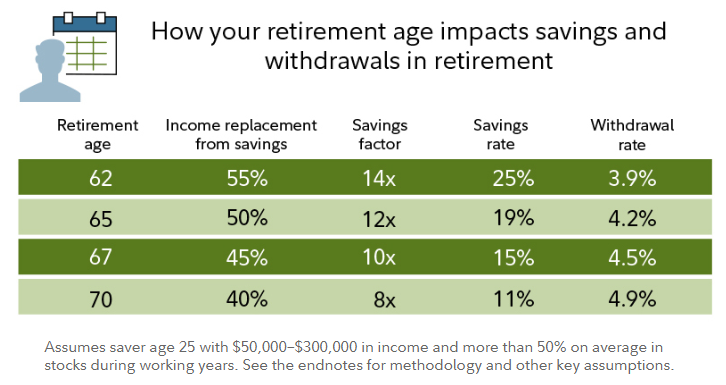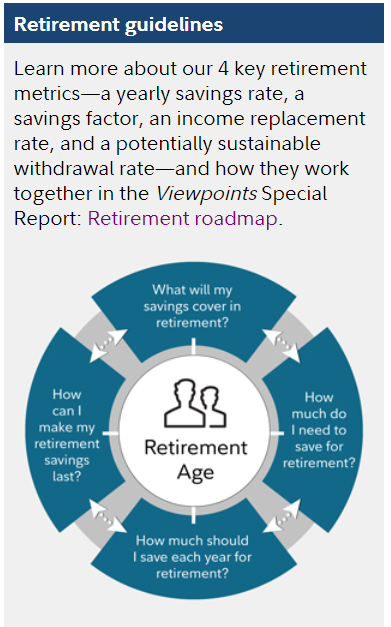4 Rules of Thumb for Retirement Savings
By: Fidelity Viewpoints
Published: July 14, 2021

Everyone's road to retirement is personal, with twists and turns that are unique to their situation. Yet most of us grapple with the same, sometimes elusive, questions, usually starting with "How much money do I need to retire?"
Of course, no one knows the precise answers to these questions because you don't know what life—or the markets—will bring. Still, you need to know where you stand to make decisions along the way that will help you have choices as retirement nears.
That's why we did the analysis and determined guidelines based on 4 key metrics: a yearly savings rate, a savings factor (savings milestones), an income replacement rate, and a potentially sustainable withdrawal rate to start you on the path to creating your retirement roadmap.
They are all interconnected, so it is important to keep each in mind, and to understand how they work together as you save for retirement and monitor your progress. We will focus on each metric—and associated guidelines—in separate articles, and we've included tools and interactive widgets to help you explore the impact of changing assumptions on these individual guidelines.
Here are 4 common retirement questions—and rules of thumb for each (assuming a retirement age of 67, which is the full Social Security benefits age for those born in 1960 or later). Of course, your particular needs may be different, which is why you should consider working with a professional to build a personalized plan. But the following guidelines offer a starting point.
- What will my savings cover in retirement? For most people, Social Security will provide an income base in retirement with the rest coming from savings. But how much should you assume will come from savings? Fidelity's rule of thumb is to save enough to replace at least 45% of your preretirement income,1 after accounting for Social Security.
Read Viewpoints on Fidelity.com: What will my savings cover in retirement? - How much do I need to save for retirement? Every journey should begin with a goal. Until you know the goal, it is hard to figure out whether you are on the right path. One simple way of estimating and monitoring your retirement savings goal is with our age-based savings factors. These are savings milestones expressed as multiples of your current income. Based on our analysis, we suggest aiming to save 1X your current income by 30, 3x by 40, 6x by 50, 8x by 60, and 10x by 67.2
Read Viewpoints on Fidelity.com: How much do I need to save for retirement? - How much should I save each year for retirement? For a high level of confidence that you can maintain your lifestyle in retirement, we suggest aiming to save at least 15% of your pre-tax income3 a year over the course of your working life. This may seem like a lot, but it includes all retirement savings across different accounts plus any employer contributions. Of course, you may not be able to do this every year, but there are always ways to catch up along the way.
Read Viewpoints on Fidelity.com: How much should I save for retirement?
- How can I make my retirement savings last? One of the most challenging questions many retirees face is how much to withdraw from their savings in retirement. Withdraw too much and you risk running out of money. Withdraw too little and you may not live the life you want to in retirement. Our guideline is to limit withdrawals to 4% to 5% of your initial retirement savings4 , then keep increasing this withdrawal based on inflation.
Read Viewpoints on Fidelity.com: How can I make my savings last?
Retirement age and Social Security benefits are key
All these guidelines depend on a number of factors, especially the age at which you retire. The average retirement age in America is about 65 for men and 63 for women5. At 62, you can start claiming Social Security benefits. But postponing claiming can increase your monthly benefit by 8% every year you delay between age 62 and 70. Delaying can also extend the period over which your retirement savings can grow, and reduce the number of years to be funded by those savings.
So the age at which you choose to stop working can have a big impact on how much income you need from your own savings. This, in turn affects the values for other retirement guidelines—savings rate, savings factors, and sustainable withdrawal rates (see table). Remember, these guidelines are all linked together.
While you may not be able to pinpoint exactly how much income you may need in retirement, you probably have an idea about when you want to retire. If you're planning to retire early, you may want to use the rules of thumb for age 62. If you are planning to work longer, the rules for age 70 might be more appropriate for you.

Things to keep in mind
Our guidelines assume no pension income, and we make a number of other assumptions, including continuous employment, uniform wage growth, and contribution amounts increasing with the wage growth. We acknowledge that individual circumstances are different and may vary through time. That is why we have applied a “strong plan” framework to our analysis, stress testing these guidelines to be successful in 9 out of 10 market conditions across a broad range of investment mixes (see footnotes for methodology and other key assumptions6).
To get a sense of where you stand, answer 6 simple questions and get your Fidelity Retirement Score.SM For a more in-depth analysis, go to our Planning & Guidance Center. Along the way, and particularly as you get closer to retirement, it's always a good idea to work with a financial advisor to create a retirement income plan.
This information is intended to be educational and is not tailored to the investment needs of any specific investor.
1. The income replacement rate is the percentage of preretirement income that an individual should target replacing in retirement. The income replacement targets are based on Consumer Expenditure Survey (BLS), Statistics of Income Tax Stat, IRS tax brackets, and Social Security Benefit Calculators. The 45% income replacement target assumes no pension income, and a retirement and Social Security claiming age of 67, which is the full Social Security benefit age for those born in 1960 or later. For an earlier retirement and claiming age, this target goes up due to lower Social Security retirement benefits. Similarly, the target goes down for a later retirement age. For a retirement age of 65, this target is defined as 50% of preretirement annual income and for a retirement age of 70, this target is defined as 40% of preretirement income.
2. Fidelity has developed a series of salary multipliers in order to provide participants with one measure of how their current retirement savings might be compared to potential income needs in retirement. The salary multiplier suggested is based solely on your current age. In developing the series of salary multipliers corresponding to age, Fidelity assumed age-based asset allocations consistent with the equity glide path of a typical target date retirement fund, a 15% savings rate, a 1.5% constant real wage growth, a retirement age of 67 and a planning age through 93. The replacement annual income target is defined as 45% of pre-retirement annual income and assumes no pension income. This target is based on Consumer Expenditure Survey (BLS), retirement Statistics of Income Tax Stat, IRS tax brackets and Social Security Benefit Calculators. Fidelity developed the salary multipliers through multiple market simulations based on historical market data, assuming poor market conditions to support a 90% confidence level of success.
These simulations take into account the volatility that a typical target date asset allocation might experience under different market conditions. Volatility of the stocks, bonds and short-term asset classes is based on the historical annual data from 1926 through the most recent year-end data available from Ibbotson Associates, Inc. Stocks (domestic and foreign) are represented by Ibbotson Associates SBBI S&P 500 Total Return Index, bonds are represented by Ibbotson Associates SBBI US Intermediate Term Government Bonds Total Return Index, and short term are represented by Ibbotson Associates SBBI 30-day US Treasury Bills Total Return Index, respectively. It is not possible to invest directly in an index. All indices include reinvestment of dividends and interest income. All calculations are purely hypothetical and a suggested salary multiplier is not a guarantee of future results; it does not reflect the return of any particular investment or take into consideration the composition of a participant’s particular account. The salary multiplier is intended only to be one source of information that may help you assess your retirement income needs. Remember, past performance is no guarantee of future results. Performance returns for actual investments will generally be reduced by fees or expenses not reflected in these hypothetical calculations. Returns also will generally be reduced by taxes.
3. Fidelity’s suggested total pretax savings goal of 15% of annual income (including employer contributions) is based on our research, which indicates that most people would need to contribute this amount from an assumed starting age of 25 through an assumed retirement age of 67 to potentially support a replacement annual income rate equal to 45% of preretirement annual income (assuming no pension income) through age 93. See footnote No. 2 for investment growth assumptions.
4. The sustainable withdrawal rate is defined as an inflation-adjusted annual withdrawal rate, and expressed as a percentage of your initial (at retirement) savings balance. This rate is estimated to be 4.5%, assuming a retirement age of 67 and a planning age through 93. See footnote No. 2 for investment growth assumptions
5. "Average Retirement Age for Men and Women, 1962-2016," Center for Retirement Research at Boston College, March 2018, http://crr.bc.edu/wp-content/uploads/2015/10/Avg_ret_age_men.pdf.
6. The savings factor, savings rate, and withdrawal rate targets are based on simulations based on historical market data. These simulations take into account the volatility that a variety of asset allocations might experience under different market conditions. Given the above assumptions for retirement age, planning age, wage growth, and income replacement targets, the results were successful in 9 out of 10 hypothetical market conditions where the average equity allocation over the investment horizon was more than 50% for the hypothetical portfolio. Remember, past performance is no guarantee of future results. Performance returns for actual investments will generally be reduced by fees or expenses not reflected in these hypothetical calculations. Returns will also generally be reduced by taxes.
The savings factor, savings rate, and withdrawal rate targets are hypothetical illustrations, do not reflect actual investment results or actual lifetime income, and are not guarantees of future results. Targets do not take into consideration the specific situation of any particular user, the composition of any particular account, or any particular investment or investment strategy. Individual users may need to save more or less than the illustrated targets depending on their retirement age, life expectancy, market conditions, desired retirement lifestyle, and other factors.
Fidelity Brokerage Services LLC, Member NYSE, SIPC, 900 Salem Street, Smithfield, RI 02917
741021.6.3




